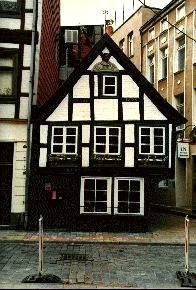|
|||||||||||||||||
|
The city of Schwerin was the capital of the Grand Duchy of Mecklenburg Schwerin. Schwerin is located about 50 miles south of the Baltic Sea in the Mecklenburg Lake District. It is surrounded by ten lakes. The largest of these lakes is the Schweriner See (Lake Schwerin). Schwerin's Altstadt (old town) lies between two other lakes, the Burgsee and the Pfaffenteich. Schwerin's history started over 800 years ago and this makes it the oldest city in Mecklenburg. It was founded in the 12th century by Henry the Lion. The Slavic tribe that had occupied the region called it "Zuarin," meaning "region of many animals", and this name stayed with it. During the Thirty Years War, the entire Mecklenburg region was devastated. Eventually the Swedes took over Schwerin as they did most of Mecklenburg. The disaster of losing the war was followed twenty years later by a devastating fire that destroyed almost all the houses in town. Then in the early 1700's, Schwerin began a come-back and by the early to mid-1800s, it really blossomed.
The castle built in Mecklenburg Schwerin during the time of the Grand Dukes is still there. It was the last home of the Mecklenburg royal family, who resided in this massive palace until 1918 when they abdicated. The palace is on an island located where the Schweriner See and Burgsee meet. These lakes are full of ducks and swans and the banks of the lakes are lined with weeping willows. Palaces and castles have been built on this spot for almost a thousand years. Arab traders mentioned the island in their writings and the king of the original Slavic tribe that settled here built his castle on this spot. Eventually the island was beseiged and taken by Henry the Lion. When the Mecklenburg royal line came into power, they took up residence here in the mid-1300s. Much of the palace as it stands today was built between 1843 and 1857. Only four historical parts from the 16th and 17th centuries remained a part of the palace. The sections, old and new, are of different architectural styles, but they blend well. The castle has fifteen turrets, both large and small, and at various heights. The main tower, facing the palace gardens, is 227 feet high. The castle has 80 rooms. Although many of the buildings in East Germany were left to decay during the Soviet era, that is not true of the castle. Fortunately the government kept it maintained while the area was part of East Germany and used the facility as an educational school for kindergarten teachers. Since the reunification, it is being refurbished and is open for tourists. Across from the palace today, on the site of the old royal gardens (the Alter Garten), is From 1934 to 1952 Schwerin was the capital of the German state of Mecklenburg, and from 1952 to 1990 it was capital of Schwerin District, East Germany. Schwerin is currently the capital of the German state of Mecklenburg-West Pomerania and has a population of about 130,000 people. |
|||||||||||||||||
|



 The Altstadt is dotted
with pastel Renaissance houses, half-timbered houses and has cobbled streets. The unusual town hall consists of four connected timber-framed houses with
a neo-Gothic facade constructed in stages from 1351 though 1835. One of the other prominent buildings is the Neuen Gebäude (New Building) built in
1783 and created by architect Johann Joachim Busch. It has twelve Doric and Attic columns.
The Altstadt is dotted
with pastel Renaissance houses, half-timbered houses and has cobbled streets. The unusual town hall consists of four connected timber-framed houses with
a neo-Gothic facade constructed in stages from 1351 though 1835. One of the other prominent buildings is the Neuen Gebäude (New Building) built in
1783 and created by architect Johann Joachim Busch. It has twelve Doric and Attic columns. the Staatliches Museum. Duke Christian Ludwig II. had a passion for Dutch art and
the museum has an excellent collection of Dutch and Flemish masters from the 17th century. It also houses paintings by famous British, French and German
artists. Another landmark that stands out in Schwerin is the Dom, or cathedral.
the Staatliches Museum. Duke Christian Ludwig II. had a passion for Dutch art and
the museum has an excellent collection of Dutch and Flemish masters from the 17th century. It also houses paintings by famous British, French and German
artists. Another landmark that stands out in Schwerin is the Dom, or cathedral.